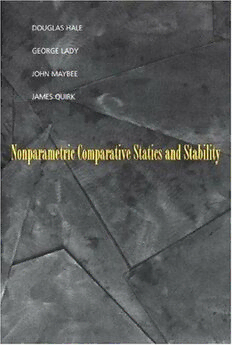Table Of ContentNonparametric Comparative Statics and Stability
Nonparametric
Comparative Statics
and Stability
DOUGLAS HALE
GEORGE LADY
JOHN MAYBEE
JAMES QUIRK
PRINCETON UNIVERSITY PRESS
PRINCETON, NEW JERSEY
Copyright © 1999 by Princeton University Press
Published by Princeton University Press, 41 William Street,
Princeton, New Jersey 08540
In the United Kingdom: Princeton University Press,
Chichester, West Sussex
All Rights Reserved
Library of Congress Cataloging-in-Publication Data
Nonparametric comparative statics and stability / by Douglas Hale ...
[et al.].
p. cm.
Includes bibliographical references and index.
ISBN 0-691-00690-3 (cloth : alk. paper)
1. Economics, Mathematical. 2. Macroeconomics—Mathematical
models. 3. Equilibrium (Economics). I. Hale, Douglas, 1946-
HB135.N664 1999
330'.01'51-dc21 98-55311
CIP
This book has been composed in Times Roman with Helvetica Display
The paper used in this publication meets the minimum requirements of
ANSI/NISO Z39.48-1992 (R1997) ( Permanence of Paper)
http: //pup.pnnceton.edu
Printed in the United States of America
1 3 5 7 9 1 0 8 6 4 2
32101 032794628
To Yvonne M. M. Bishop
Two True Scholars: David F. Lady and Dorothy E. Lady
Carol
Shirley
Contents
PREFACE ix
1. Nonparametric Analysis 3
1.1 Introduction 3
1.2 Quantitative Analysis 4
1.3 NonparametricAnalysis 6
1.4 An Example 8
1.5 Organization of the Book 11
2. Qualitative Comparative Statics and Stability 13
2.1 Introduction 13
2.2 Sign Solvability—Background 13
2.3 The Algorithmic Approach to Strong Sign Solvability 15
2.4 The Algebraic Approach to Sign Solvability 20
2.5 Sign Stability 27
2.6 Potential Stability 36
2.7 Conclusions 38
Appendix: Special Topics in Matrix Analysis 40
3. Information and Invertibility 49
3.1 Introduction 49
3.2 An Algebraic Analysis of Qualitative Invertibility 50
3.3 The Elimination Principle 56
3.4 Categorizing Information 60
3.5 The Invertibility of Matrices with Ranked Entries 63
3.6 The Invertibility of Matrices with Entries Specified
within Given Intervals 81
3.7 Summary of the Algebraic Method 85
3.8 Stability 86
4. Applications in Qualitative Comparative Statics 92
4.1 Introduction 92
viii CONTENTS
4.2 Algorithmic Principles 93
4.3 A Qualitative Analysis of the Oil Market Simulation Model 98
4.4 A Qualitative Analysis of the Oil and Gas Supply Model 104
4.5 Klein's Model I 117
4.6 Summary 121
5. The Maximization Hypothesis 122
5.1 Introduction 122
5.2 Unconstrained Maximization 122
5.3 Application: Profit-Maximizing Choices of Inputs by
a Competitive Firm 134
5.4 Constrained Maximization 136
5.5 Application: Minimizing the Cost of Production 141
Appendix: Advanced Topics in Matrix Analysis 143
6. The Correspondence Principle 150
6.1 Introduction 150
6.2 An Example 152
6.3 StabilityandSignSolvability 157
6.4 GM-Matrices 161
6.5 Scope of the Correspondence Principle 165
6.6 Interpretation 168
7. The Competitive Equilibrium: Comparative Statics 170
7.1 Introduction 170
7.2 A Competitive Economy 171
7.3 Some Historical Comments 174
7.4 Restatement of Sign Solvability 176
7.5 Sign Solvability under Walras's Law 180
7.6 Sign Solvability under Walras's Law and Homogeneity 196
8. The Competitive Equilibrium: Stability 206
8.1 Introduction 206
8.2 Stability under Walras's Law and Homogeneity 208
NOTES 223
BIBLIOGRAPHY 227
NAME INDEX 239
SUBJECT INDEX 241
Preface
The fundamental issue addressed in this book concerns the degree to
which subject matter such as economics can be considered a science,
i.e., a source of refutable hypotheses. Such a concern is not limited to
the realm of scholarly debate, but arrives with ever-increasing impor
tance in an age when many governmental and commercial policies are
derived from computer-based renditions of conceptual models from
economics and elsewhere.
Our particular experience with applied analysis includes the energy
market forecasting systems developed by the Energy Information Ad
ministration (EIA) of the U.S. Department of Energy over the decades
since the 1973-1974 oil embargo. The issues at stake in the use of these
systems include the degree of expected dependency upon foreign sources
of energy supply; the effect on energy production and costs of adopting,
or removing, the regulation of energy markets; and the consequences of
undertaking alternative polices designed to ameliorate the environmen
tal problems associated with the production and consumption of many
energy products. The outcomes of policy issues such as these have
substantial material significance for all of us; further, the design of
many specific policies depends upon exactly how the data about the
relationships at issue are used. Given this, the EIA has maintained an
aggressive interest in reviewing and determining the operational quality
of its policy analysis modeling.
The particular circumstances that led to this book can be traced in
part to the EIA model quality control program. In light of the impor
tance of modeling to the energy policy debate, a symposium was held at
the University of Colorado in 1980, with attendees invited from a broad
range of disciplines (proceedings in Greenberg and Maybee [1981]). The
papers and discussions at the symposium covered the technical issues
that needed to be resolved, and promising approaches for resolving
them, in order to understand the basis for the expected accuracy of fhe
results from large computer-based forecasting systems. Many of the
results reported here stem from investigations prompted by this sympo
sium. Some of the examples presented in Chapter 4 were initially
sponsored by the EIA as part of its continuing interest in model quality
control.

